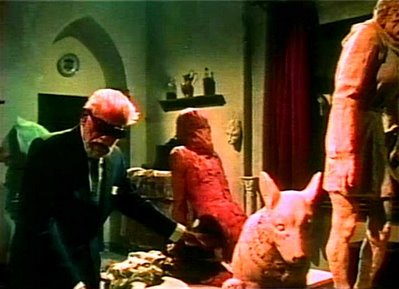Las Coleccionista de Cadáveres ("The Corpse Collectors")
1967/70, NTA/Republic Home Video, HF/OOP, 99m, VHS
This curious Spanish-American co-production starring Boris Karloff was filmed in 1967, contemporaneously with his I SPY episode "Mainly On the Plains," but not released anywhere in the world until February 1970, a full year after the actor's death. At this time, it was one of several films falsely advertised as showcasing his final performance. Uncommonly in the context of a horror film, Karloff is not top-billed; though his bearded and begoggled visage looms large in the psychedelic opening credits (with the film's title spelled out in animated bones, à la ABBOTT & COSTELLO MEET FRANKENSTEIN), that distinction falls to dashing Jean-Pierre Aumont, who stars as photojournalist Claude Marchand.
Assigned by HOLIDAY Magazine to travel to Torremolinos and charm his way past the barred doors of reclusive artist Charles Badalescu (Karloff), Marchand achieves his goal with the help of Valerie (Rosenda Montéros), an attractive local artist on friendly terms with Badalescu's protective wife and former model Tania (Viveca Lindfors). Badalescu, blinded and crippled in an automobile accident years earlier, is working on a series of commissions involving the sculptural recreations of the figures in various classic paintings. He achieves this -- in a manner requiring only slightly more ability than fellow sculptor Walter Paisley (in Roger Corman's A BUCKET OF BLOOD, 1959) -- by using actual human and animal skeletons acquired by Tania as armatures. What Badalescu doesn't know is that Tania isn't robbing graves but working with a handsome cohort (Milo Quesada, the murderous Frank in BLACK SABBATH's "The Telephone") to "arrange" the deaths of various turistas who have the misfortune to resemble figures in the paintings being recreated in three dimensions; she then dips them in a basement acid bath to provide the artist with his raw materials. Prominent among the supporting cast are Dianik Zurakowska -- one of the female figureheads of Seventies Spanish horror, whose short screen career encompassed THE SWEET SOUND OF DEATH (1965), FRANKENSTEIN'S BLOODY TERROR (1968), THE VAMPIRE'S NIGHT ORGY (1973) and SEXY CAT (1973) -- and Manuel de Blas, who subsequently played an interesting Count Dracula in the many-titled ASSIGNMENT TERROR aka DRACULA VS. FRANKENSTEIN (1969).
 Boris Karloff as the blind sculptor Charles Badalescu.
Boris Karloff as the blind sculptor Charles Badalescu.
At the time of its initial release, CAULDRON OF BLOOD was generally dismissed by horror fans; Karloff's role wasn't prominent enough, his expressive eyes were covered throughout (either by heavy black goggles or a grotesque makeup showing his eyes welded closed), and the modernist style of the film was jarring, its jazzy score (credited to Ray Ellis, though it sounds very much like a Spanish film score of its era) and its garish lighting not in keeping with the traditional qualities found in Karloff's best pictures. Revisited today, with more familiarity with Spanish horror cinema and its own traditions under our belt, it's easier to appreciate for what it is -- not a good film by any means, but more interesting than previously thought.

NTA/Republic Home Video's long-out-of-print videocassette naturally presents the film dubbed into English, but the job is incompletely done, with one scene of Spanish actors talking to one another in their native language subtitled in English (the words are not only horizontally cropped in this pan&scan transfer, but may also be vertically so, depending on your monitor's calibration). Also, scenes involving Aumont, Quesada and a young Spanish actor find the boy speaking in untranslated Spanish in response to their English dialogue; amusingly, they all seem to understand each other. As with many Republic tapes dating back to their earlier NTA incarnation, the film is presented in what appears to be its TV version; there is a brief through-the-suds glimpse of Zurokowska's nipple in a bubble bath scene, but more prolonged views of her nude body are splicily excised from a later sequence. (Nudity would also have been forbidden in any Spanish film of this vintage.) Some sources list this film as having been photographed in a scope ratio, but it was actually shot in a "Panoramico" (1.85:1) ratio, and cropped here to standard framing, with only a couple of instances of lateral scanning. The color quality of the tape looks surprisingly fresh and undated.
CAULDRON OF BLOOD is also available here as a low-frills UK import Region 2 DVD from Orbit Media. This release is also said to feature a cropped standard ratio presentation, and Kim Newman informs me that it is also lacking the nudity absent from the NTA/Republic tape. It also includes an episode of Karloff's COLONEL MARCH OF SCOTLAND YARD series ("The Silver Curtain," featuring Anton Diffring) and bonus trailers as incentive. One of the trailers, appropriately, is for the aforementioned A BUCKET OF BLOOD.
